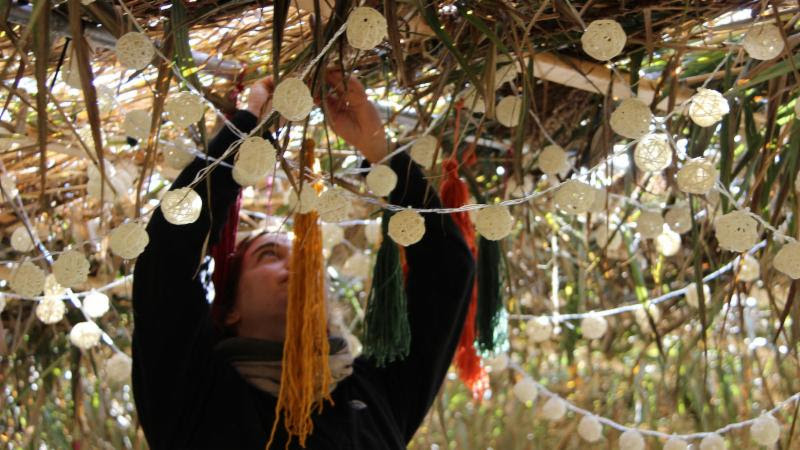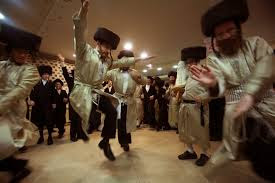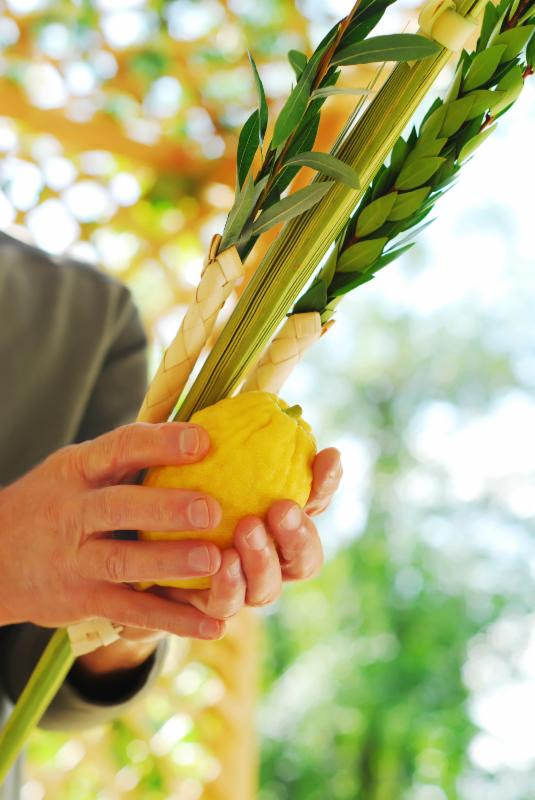Succois 2017
by devadmin | October 8, 2017 4:48 am
Exhale! With the blessings of the RBSO, we’re all still here. Seemingly we’ve been spared; at least for now. Don’t take that as a license to go out and start a brand new slate of avayrois; the RBSO is zicher watching and has you on a short leash.
This week, just as the rains are scheduled to arrive, we’ll be celebrating the joyous yoim tov of Succois, which avada you all know begins four nights after Yoim Kippur ends. It’s a holiday when we celebrate protection, avada we all know that protection is good, if you chap. And if you do, protection is avada and avada vichtig (critical). What’s pshat? Avada you recall, or at least should, that the RBSO gave the Yiddin full protection as they left Mitzrayim (Egypt) and for the 40 years that they were schlepping through the midbar. We commemorate the protective “Clouds of Glory” surrounding the Yiddin. It also commemorates how the Yiddin lived in temporary dwellings during that same time. We leave the safety and security of our houses and put ourselves under the direct protection of the RBSO and lehavdil (to diffentiate) the Chinese who manufacture the great majority of Succois and Sechach that are imported and sold all over this country.

Speaking of rain….shteltz zich di shailo (the question arises): Is rain always considered a curse on Succois? Hey, weren’t we always taught that Mayim (water) is a siman brocho (sign of blessing from above?) What’s pshat? Can water be both a curse and a brocho? Avada the answer depends on who you ask. The RambaM, The Ritva, and The Meiri (seemingly all had the same first name) write that rain is taka a curse but only on the first night of Succois, when there is a specific mitzvah to eat in the sukkah that we cannot fulfill due to the rain. On the other hand, the Bikkurei Yaakov argues that the first night of Succois is the only time when rain is not considered a curse, as it increases the reward (and the dry cleaning bill) we receive for persevering and eating in the sukkah despite the inclement weather. The Aruch HaShulchan cites an opinion that rain is only considered a curse in the land of Israel but here in golus (Diaspora,) rain is gevaldig. The Chemdas HaYamim posits that rain is only considered a curse if it starts just when you get home from shul ober it’s not if the rain began erev yom tov like it’s supposed to tomorrow here in the 5 towns and continues into yom tov. Got all that? Veyter.
It’s also a holiday where we Yiddin celebrate Christmas in October by placing tinsel, colorful lights and other hanging things, mostly made in Hong Kong or in China, all over our Succois to fulfill a mitzvah from the heylige Toirah where the RBSO told us to dwell in a succoh for seven days. It all started out with this one commandment. “You shall sit in Sukkot for seven days; all citizens of Israel will sit in Sukkot. In order that your generations shall know that I enabled the children of Israel to dwell in Sukkot when I brought them out of Egypt, I am the L-rd your God” (Vayikra 23:42-43.) Of course the Yiddin had no idea what all this meant, but many centuries later, when the codifiers of the Mishna and Gemora sat down to argue over pretty much everything, they also codified an entire Tractate of Gemora which they aptly named Succah and in which they discuss every minute detail of its observance. From architecture to interior design, all can avada be found in the Gemora where we also learn about its height limitations and of course the role that decorations play.
Leave it up to the early entrepreneurs to figure out what all this really meant: big business! Over the years, Succois have become works of art and their structures and designs worthy of architectural digest. Today’s Succois come in canvas, fiberglass, wood, glass and other materials. They come soft and hard. Sechach options include bamboo, evergreens, slats of wood sewn together, and more. It’s likely this business that has catapulted the Chinese economy past that of the United States. Decorations have gone from the simple ones the kids made for the 15-20k of yearly tuition we paid from 3 year nursery through kindergarten, to silk screened walls of the Kiddush, also, of course, made in China. Where in the Gemora does it tell us that China is so closely related to our Yom Toiv of Succois? Nowhere! Is the day of Art Scroll being printed in China far away?
The heylige Gemora (Succah 10a) tells us that one should decorate his Sukkah with “decorated cloths, and hang nuts, almonds, peaches, pomegranates, grapes, wheat, wine, and oil.” How all that morphed into Christmas and other holiday décor, dos veys ich nisht (I have no clue) ober I suspect it has something to do with money, cheap goods made overseas, and an entrepreneurial spirit imbued in Yeshiva bochurim who had imagination and drive.

Some say that the first succoh was built by our zeyde Avrahom Oveenu who sat in his tent, with the flaps folded up on all four sides, so he could welcome weary wayfarers (guests) from every direction. Gishmak mamish! We are taught that all male adults and boys who are past the age of bar mitzvah are required to “laysheiv” (dwell or sit) in the Sukkah for the prescribed seven day period. Women and girls are exempt from the mitzvah or commandment to dwell or sit in a Sukkah, although, if they prefer to eat or sleep in a Sukkah, they are certainly permitted to do so. Avada some do so knowing that it comes with the ultimate in protection; gishmak mamish (very enjoyable.)
Efsher you were taka wondering why we celebrate Succois in the fall. Didn’t we leave Mitzrayim in the month of Nissan (typically April?) Guess what. The same kasha bothered The Tour Oirach Chaim (825) who taka asks it. Nu- do you realize what progress you’ve made this past year? Asking the same kasha as the Tour? Impressive mamish, pat yourselves on the back. Ober he was The Tour and he also had an answer which goes like this: The month of Nissan is in the spring when it is customary for people to dwell in cottages and sit in the shade of huts. At that time of year, who would notice us doing something unique as everyone’s in the hut? How would they know that we dedicated Yiddin are doing so just to fulfill the RBSO’s commandment? Therefore, the Toirah commands us to build our succahs in the month of Tishrei, when the rains set in and everyone leaves their cottages to return to their homes and to thank the RBSO for hovering over us with protective clouds. Ober in reality, this doesn’t work out too well because as soon as it’s raining, we’re all back indoors. Mistama (likely) you all know that on the first night, rain notwithstanding, we are commanded to wait for some period of time before having the meal indoors but practically speaking, if it’s raining, it’s a washout and indoors we all run. Efsher Succois should be moved to the spring?
Says the heylige Toirah (Lev. 23:39): “But on the fifteenth day of the seventh month, when you have gathered in the fruit of the land, you shall keep a feast to the Lord seven days; on the first day shall be a shabbis, and on the eighth day shall be a shabbis. And you shall take for yourselves on the first day the fruit of a beautiful tree, date branches, a branch of a leafy tree, and willows of the brook and you shall rejoice before the Lord your God seven days.” Asks the Midrash Tanchumah, “Why is it called the first day, indeed it’s actually the 15th day of the month? Answer: The verse refers to it as the ‘first day’ because it’s the first day of the counting of new sins. On Yoim Kippur the Yiddin fast and daven and of course do t’shuva (repent.) On the first day of Succois the people take their fully adorned lulovim and dance in praise before the RBSO and He forgives them and says, ‘I will erase all your previous sins and start counting new sins from this day forward.’ The Medrish Tanchumah says that the first day of Succois is called “Rishon L’Cheshbon Avoinos, “the first day that the RBSO starts to count our avayrois since doing Teshuva on Yoim Kippur.” Nu, mistama you’re wondering…hey….what about the avayrois we committed in the days between Yoim Kippur and Succois? I know you didn’t wait. Do they not count? Did we get a freebie? Wouldn’t that be nice? And mistama you’re saying…”if only the Ruv would’ve sent this Toirah out a few days earlier”…. You’re mamish still giferlich. Says the heylige Gemora (Yuma 86b) that when we do Tshuva out of fear “Zidonois Na’aseh K’Shgogois” meaning that the RBSO downgrades our intentional avayrois to accidental ones, those without intent. Perhaps the forerunner of the plea deal system, the first ever downward departure (for my lawyer readers) and does not punish us. However when we do Tshuva out of love for the RBSO, “Zidoinois Na’aseh K’Zichuyois” (our sins become our merits:) we get a second level downgrade of the sin. And just like that, our avayrois turn into mitzvois. Well- blow me down! Such is the power of Tshuva Me’Ahava. Says Reb Levi Yitzchok MiBerdichev (aka: the Kedushas Levi) azoy: that on Yoim Kippur we do Tshuva out of fear. Avada we’re frightened stiff, want to live, want to prosper and are willing to do anything and say anything. As proof, we swing live chickens over our heads, share a mikveh with a few degenerates looking for a cheap thrill, shtupp suppositories where the sun doesn’t shine, even refrain from texting and spend kimat the entire day mumbling words we don’t understand while beating our chests a few hundred times and punishing our bodies; also the people sitting immediately to our right and left. Our fate hangs in the balance. The RBSO ignores our avayrois and we get a pass. Succois, on the other hand, is a Yom Toiv of Simcha and great joy. It’s a time when we do Tshuva out of extreme love for the RBSO. In fact, we are instructed to ‘be happy’ on this holiday. Weather permitting, we sit in the Succah and enjoy mouthwash in the morning and Yom Toiv showers, both in and out of the house. And since we’re doing all this loving, our old avayrois are now turned into mitzvos. Are you following all this? Good! Let’s go veyter.
Therefore, when Succois starts and we do Tshuva Me’Ahava, the RBSO takes out all the avayrois that he “threw away” after Yoim Kippur when he forgave us and starts to count them again. Why? Ober, since these are now mitzvos, the RBSO wants to recount them in order to credit us for these “mitzvos”. Is that beautiful or what? Says the Shulchan Aruch, Orach Chaim (529:2): “A man is obligated to be happy and good at heart on the festivals, he, his wife and children and whoever is around him. How does he make them happy? To the kinderlach (the minors) he gives roasted grain and nuts. He buys the women garments and jewelry, according to his means (or level of guilt.) And he is obligated to feed the strangers, orphans, widows as well as other poor people.”
And how does he make himself happy? Taka an excellent kasha. Never mind you chazzir, I shouldn’t have asked. Ober the answer is quite simple. Ershtens (firstly): had he behaved properly, he would have no reason to be buying the eishes chayil (wife) any jewelry, instead he’d be giving her nuts as well, if you chap. Sadly ober (however), we all know that most men taka make themselves happy only too often. Or worse, find themselves in a situation rachmono litzlon (heaven forbid) with a happy ending, if you chap, and now it’s payback time. We are commanded to be happy and if we can’t be happy at home, efsher finding happiness outside is not so giferlich? Ver Veyst (who knows)? Nu, let’s not get lost in this schmutz, were just days past Yoim kippur and the slates for some of you are relatively clean. Ober some taka ask why the Shulchan Oruch deals only with everyone else’s happiness and not his own. Answer: Nothing makes a person happier than making others happy. Beautiful!

On Succois we are also commanded to take a lulav and esrog together. “On the first day you shall take the product of the beautiful (hadar) tree, branches of palm trees, thick branches of leafy trees, and willows of the brook and you shall rejoice before the Lord your God for seven days” (Vayikro (Leviticus) 23:40.) on this day and others, we avada like to compare size, girth and circumference. Does mine shokel (shake) more than yours?
Some say that when the Beis Hamikdash (Temple) stood in Yerusholayim, the Yiddin used the lulav and esrog only on the first day. Only the Kohanim who served in the Beis Hamikdash used these for the rest of the holiday. This, of course, didn’t sit well with the lulav and esrog growers. Who was going to invest close to or over one hundred dollars for a set they could only show off for one day? They protested vehemently. And following its (The Beis Hamkidash) destruction, the rabbis, who mistama got a healthy cut off the top, taka decreed that all Jews should wave the lulav and esrog all seven days as a remembrance of Temple days. Talk about greasing the palm…..
The medrish (Vayikrah Rabba 30:12) tells us that these items are symbols of the importance of unity among different types of Yiddin. The bringing together of the “arb’ah minim” (four species) on Succois, represents the notion that all of the Yiddin (Jews) are one, and should be viewed as such, regardless of their level of commitment to Judaism. Of course this isn’t reality; when was the last time you saw unity among Jews? Let’s learn the medrish anyway, efsher you’ll feel inclined, while waiting for the rain to stop, to say a few words about the holiday.
The “esrog” (citron) has both a taste and a fragrance, thus representing those amongst us who possess Toirah knowledge and good deeds. The “lulav” (palm branch) which lacks fragrance but has a taste contained in the dates produced by the palm tree, depicts those Yiddin who possess Toirah knowledge but lack good deeds. The “hadas” (myrtle branch) possesses a fragrance but lacks a taste, reflecting those Yiddin who practice good deeds but do not engage in the study of the heylige Toirah. The “aravah” (willow) branch has neither a taste nor a fragrance, representing those amongst the Yiddin who have no Toirah knowledge and do not engage in good deeds. The differences between us Jews may be substantial but, like the lulav and esrog which must be held together for the shokeling (waving) ritual, only when Yiddin come together, do they merit a brocho. Nebech (very sadly,) this only happened once when the Yiddin were lined up for the gas chambers; efsher one day.
The Sefer Bahir, a kabbalistic work almost 2,000 years old, describes the four species as four parts of a human being:
1. The Esrog represents the heart, the seat of our emotions.
2. The Hadas (myrtle) has leaves shaped like an eye.
3. The Lulav (date palm) represents the spine, from where our actions emanate.
4. The Aravah (willow) represents the lips, our speech.

The four species must be taken together as a unit. To achieve happiness, one must use all of one’s faculties in unison. We shouldn’t say one thing and feel another; yet another nice thought but rarely practiced. We must unify our feelings, our actions, our speech and our outlook. With all of these working together, we are well on the path to self-esteem, tranquility and joy; also fewer friends.
Raboyseyee: being happy seems to be part of the mitzvah, not an easy task over another 3 day yom tov/shabbis combo, but we are to do our best. It is one of but maybe two mtizvois that we can perform with our entire body. The other that comes to mind is a trip to the mikveh.
And is that what you want to hear from the Oisvorfer or would you prefer that I go back and discuss other inyonay diyomo (interesting topics with lots of innuendo?) Let me know.
Chag Somayach- a Gittin Yom Toiv-
The Heylige Oisvorfer Ruv
Yitz Grossman
Source URL: https://oisvorfer.com/succois-2017/
